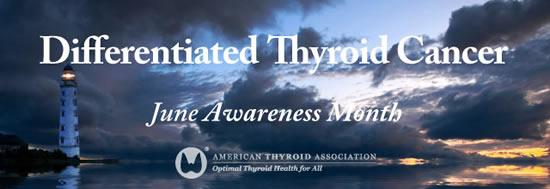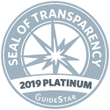
Clinical Thyroidology for the Public summarizes selected research studies discussed in the previous month’s issue of Clinical Thyroidology, an official publication of the American Thyroid Association. Editor-in-chief, Alan Farwell, MD, FACE
Volume 17 Issue 6
Available in pdf format for saving and printing and Web page format for viewing online
PDF Format for Saving and Printing
Clinical Thyroidology for the Public Volume 17 Issue 6 (PDF file, 2.62 MB)
TABLE OF CONTENTS – Web Format
THYROID CANCER
Adherence to treatment guidelines improves outcomes in medullary thyroid cancer
Medullary thyroid cancer (MTC) is a rare form of thyroid cancer with a worse prognosis compared to the more common papillary thyroid cancer. The American Thyroid Association (ATA) published the first set of guidelines to standardize MTC management in 2009; revised guidelines were then released in 2015. The goal of this study was to evaluate national adherence to the ATA guidelines for MTC, identify factors that can affect adherence, and assess whether guideline adherence affects patient survival.
McMullin JL et al. Improved adherence to ATA medullary thyroid cancer treatment guidelines. Ann Surg Oncol 2023;30(12):7165-7171; doi: 10.1245/s10434-022-12734- 3. PMID: 36367629.
THYROID CANCER
Radioactive iodine treatment for children with low-risk thyroid cancer – to give or not to give?
Most children with thyroid cancer do very well as there are effective treatments available. The most recent American Thyroid Association guidelines to treat thyroid cancer in children no longer recommend radioactive iodine therapy for those with low risk cancer. The researchers designed this study to find out if doctors changed how they treated the children with low-risk thyroid cancer after the change in the guidelines.
Bojarsky M, et al. Outcomes of ATA low-risk pediatric thyroid cancer patients not treated with radioactive iodine Therapy. J Clin Endocrinol Metab 2023;108(12):3338-3344; doi: 10.1210/clinem/dgad322. PMID: 37265226.
THYROID CANCER
Completion thyroidectomy may not always be necessary in the setting of cancer spreading to the lymph nodes
Since many of the thyroid cancers discovered are low risk, there has been an increase in removal of the lobe containing the cancer rather than removing the entire thyroid gland. When cancer is found in the lymph nodes, this may lead to additional surgery to remove the remaining lobe and to consider radioactive iodine therapy. The goal of this study was to examine the clinical course of patients with cancer found in the lymph nodes after a lobectomy for thyroid cancer.
Alameer E et al. Partial thyroidectomy with incidental metastatic lymph nodes. JAMA Otolaryngol Head Neck Surg 2024;150(1):49-56. doi: 10.1001/jamaoto.2023.3668. PMID: 37971746.
THYROID NODULES
How good is ultrasound in the initial detection of thyroid nodules?
Thyroid ultrasound is the best study when a physician feels an abnormality on the patient’s neck, the patient has a compressive neck symptoms like trouble swallowing, or to monitor a previously diagnosed thyroid nodule. However, some ultrasounds are also ordered due to vague complaints of fatigue, which contribute to the rise in the number of ultrasounds performed in the United States. This study was done to determine reasons for obtaining a thyroid ultrasound and determine under what circumstances nodules detected
Kennedy E et al. Rates of detecting thyroid nodules recommended for biopsy with ultrasound: are all indications equal? Thyroid 2023;33(12):1434-1440; doi: 10.1089/ thy.2023.0234. PMID: 37981778.
THYROID EYE DISEASE
Artificial intelligence as a screening tool to detect severity of thyroid eye disease
Thyroid Eye Disease (TED) is an autoimmune condition that can affect patients with Graves’ disease. Making an early diagnosis of TED is very important so it can be monitored and treated before the disease permanently damages the eye. This study looks at how good artificial intelligence is in recognizing and assessing the severity of TED and compared it to ophthalmologists specialized in TED.
Lin LY et al. A deep learning model for screening computed tomography imaging for thyroid eye disease and compressive optic neuropathy. Ophthalmol Sci 2023;4(1):1000412; doi: 10.1016/j.xops.2023.100412. PMID: 38046559.
HYPOTHYROIDISM & HYPERTHYROIDISM
The combined effect of immune checkpoint inhibitors and tyrosine kinase inhibitors on thyroid function
Thyroid abnormalities are frequent side effects of classes of drugs known as immune checkpoint inhibitors (ICIs) and tyrosine kinase inhibitors (TKIs) used to treat non-thyroid cancers. Initial reports indicate a potential increase in rates of thyroid abnormalities during combined ICI+TKI therapy. This study examines the effect of ICI+TKI therapy on thyroid function in cancer patients.
Tsai K et al. The combined effect of immune checkpoint inhibitors and tyrosine kinase inhibitors on thyroid function. Thyroid 2024;34(2):158-166; doi: 10.1089/thy.2023.0542. PMID: 38069567.



